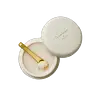What's inside
What's inside
 Key Ingredients
Key Ingredients

 Benefits
Benefits

 Concerns
Concerns

 Ingredients Side-by-side
Ingredients Side-by-side

Polyglyceryl-2 Triisostearate
EmulsifyingCaprylic/Capric Triglyceride
MaskingSqualane
EmollientMica
Cosmetic ColorantButyrospermum Parkii Oil
EmollientHelianthus Annuus Seed Wax
Skin ConditioningPhytosteryl/Octyldodecyl Lauroyl Glutamate
Skin ConditioningDimer Dilinoleyl Dimer Dilinoleate
EmollientSilica
AbrasiveOpuntia Ficus-Indica Seed Oil
EmollientDisteardimonium Hectorite
StabilisingEuphorbia Cerifera Wax
Ceramide NP
Skin ConditioningPalmitoyl Tripeptide-1
Skin ConditioningOpuntia Ficus-Indica Leaf Cell Extract
Skin ProtectingHibiscus Syriacus Callus Extract
AntioxidantRutin
AntioxidantSodium Hyaluronate
HumectantTocopherol
AntioxidantRosa Canina Fruit Oil
EmollientHydrolyzed Collagen
EmollientTribehenin
EmollientHelianthus Annuus Seed Oil
EmollientButylene Glycol
HumectantEthylhexyl Palmitate
EmollientSorbitan Isostearate
EmulsifyingPolyglyceryl-2 Triisostearate, Caprylic/Capric Triglyceride, Squalane, Mica, Butyrospermum Parkii Oil, Helianthus Annuus Seed Wax, Phytosteryl/Octyldodecyl Lauroyl Glutamate, Dimer Dilinoleyl Dimer Dilinoleate, Silica, Opuntia Ficus-Indica Seed Oil, Disteardimonium Hectorite, Euphorbia Cerifera Wax, Ceramide NP, Palmitoyl Tripeptide-1, Opuntia Ficus-Indica Leaf Cell Extract, Hibiscus Syriacus Callus Extract, Rutin, Sodium Hyaluronate, Tocopherol, Rosa Canina Fruit Oil, Hydrolyzed Collagen, Tribehenin, Helianthus Annuus Seed Oil, Butylene Glycol, Ethylhexyl Palmitate, Sorbitan Isostearate
Caprylic/Capric Triglyceride
MaskingHelianthus Annuus Seed Oil
EmollientButyrospermum Parkii Butter
Skin ConditioningTribehenin
EmollientRicinus Communis Seed Oil
MaskingHelianthus Annuus Seed Wax
Skin ConditioningCandelilla Cera
EmollientCopernicia Cerifera Cera
EmollientSilica
AbrasiveBisabolol
MaskingPolyglyceryl-3 Diisostearate
EmulsifyingSimmondsia Chinensis Seed Oil
EmollientGlycine Soja Oil
EmollientHydrogenated Castor Oil
EmollientLecithin
EmollientTocopherol
AntioxidantAscorbyl Palmitate
AntioxidantCalendula Officinalis Flower Extract
MaskingRosa Hybrid Flower Extract
Skin ConditioningMalva Sylvestris Flower/Leaf Extract
Skin ConditioningCitric Acid
BufferingBenzyl Alcohol
PerfumingIron Oxides
Caprylic/Capric Triglyceride, Helianthus Annuus Seed Oil, Butyrospermum Parkii Butter, Tribehenin, Ricinus Communis Seed Oil, Helianthus Annuus Seed Wax, Candelilla Cera, Copernicia Cerifera Cera, Silica, Bisabolol, Polyglyceryl-3 Diisostearate, Simmondsia Chinensis Seed Oil, Glycine Soja Oil, Hydrogenated Castor Oil, Lecithin, Tocopherol, Ascorbyl Palmitate, Calendula Officinalis Flower Extract, Rosa Hybrid Flower Extract, Malva Sylvestris Flower/Leaf Extract, Citric Acid, Benzyl Alcohol, Iron Oxides
Alternatives
Ingredients Explained
These ingredients are found in both products.
Ingredients higher up in an ingredient list are typically present in a larger amount.
This ingredient is an emollient, solvent, and texture enhancer. It is considered a skin-softener by helping the skin prevent moisture loss.
It helps thicken a product's formula and makes it easier to spread by dissolving clumping compounds.
Caprylic Triglyceride is made by combining glycerin with coconut oil, forming a clear liquid.
While there is an assumption Caprylic Triglyceride can clog pores due to it being derived from coconut oil, there is no research supporting this.
Learn more about Caprylic/Capric TriglycerideHelianthus Annuus Seed Oil is the oil derived from the seeds of a Sunflower. Sunflower seed oil is non-fragrant. It is an emollient, meaning it helps to soften the skin.
Sunflower seed oil contains many fatty acids. The fatty acids found in sunflower seeds include (from highest amount to least): linoleic acid, myristic acid, palmitic acid, stearic acid, arachidic acid, oleic acid, and linolenic acid.
These fatty acids help the skin create ceramides. Ceramides play a role in repairing the skin barrier.
Helianthus Annuus Seed Oil helps moisturize the skin. This in turn helps the skin look more rejuvenated and smoother.
Sunflowers are rich in vitamin E.
Historians believe Indigenous cultures of North America domesticated sunflowers before corn. Thus they relied on sunflower oil for a variety of uses. One such use is moisturizing skin and hair.
Sunflower seed oil may not be fungal acne safe. We recommend speaking with a professional if you have any concerns.
Learn more about Helianthus Annuus Seed OilHelianthus Annuus Seed Wax is created from the common sunflower.
Sunflower seed wax is made up of long chain non-glyceride esters, a small amount of fatty alcohols, and fatty acids.
This ingredient is often used to enhance the texture of products. The fatty acid properties also help hydrate the skin.
Learn more about Helianthus Annuus Seed WaxSilica, also known as silicon dioxide, is a naturally occurring mineral. It is used as a fine, spherical, and porous powder in cosmetics.
Though it has exfoliant properties, the function of silica varies depending on the product.
The unique structure of silica enhances the spreadability and adds smoothness, making it a great texture enhancer.
It is also used as an active carrier, emulsifier, and mattifier due to its ability to absorb excess oil.
In some products, tiny microneedles called spicules are made from silica or hydrolyzed sponge. When you rub them in, they lightly polish away dead skin layers and enhance the penetration of active ingredients.
Learn more about SilicaTocopherol (also known as Vitamin E) is a common antioxidant used to help protect the skin from free-radicals and strengthen the skin barrier. It's also fat soluble - this means our skin is great at absorbing it.
Vitamin E also helps keep your natural skin lipids healthy. Your lipid skin barrier naturally consists of lipids, ceramides, and fatty acids. Vitamin E offers extra protection for your skin’s lipid barrier, keeping your skin healthy and nourished.
Another benefit is a bit of UV protection. Vitamin E helps reduce the damage caused by UVB rays. (It should not replace your sunscreen). Combining it with Vitamin C can decrease sunburned cells and hyperpigmentation after UV exposure.
You might have noticed Vitamin E + C often paired together. This is because it is great at stabilizing Vitamin C. Using the two together helps increase the effectiveness of both ingredients.
There are often claims that Vitamin E can reduce/prevent scarring, but these claims haven't been confirmed by scientific research.
Learn more about TocopherolTribehenin comes from glycerin and behenic acid.
It is used as an emollient, or moisturizer. Emollients form a thin barrier on skin to prevent moisture from escaping.
This ingredient may not be Malassezia folliculitis, or fungal-acne safe.
Learn more about Tribehenin